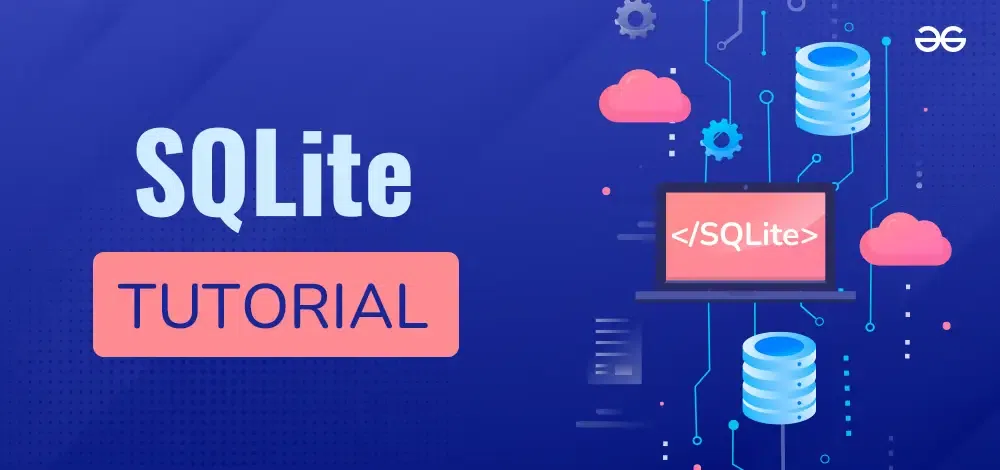This SQLite Tutorial is your ultimate guide to mastering this powerful, lightweight database management system. SQLite is widely used in mobile applications, embedded systems, and small to medium-sized websites due to its simplicity and efficiency.
In this tutorial, we'll walk you through everything you need to know about SQLite, from setting it up and creating your first database to performing complex queries and optimizing performance.
Whether you're a beginner or an experienced developer, you'll find valuable insights and practical examples to help you make the most of SQLite's features. So, without further ado, let's dive into the tutorial to start learning SQLite.
 SQLite Tutorial
SQLite TutorialWhat is SQLite?
Before exploring the topics SQLite it is very important to understand what is SQLite. So SQLite is a lightweight, self-contained database engine that's easy to use and doesn't require a separate server to operate. It's embedded into applications, making it ideal for mobile apps, small websites, and projects where simplicity and speed are crucial.
Unlike other databases, SQLite stores all data in a single file, making it portable and easy to manage. Despite its small size, it supports most SQL standards, allowing developers to perform complex queries and transactions efficiently. SQLite is reliable, fast, and perfect for many everyday database needs without the overhead of a full-fledged database system.
Features of SQLite
SQLite offers several notable features that make it a popular choice for developers:
- Self-contained: SQLite is a complete database system contained in a small library, eliminating the need for a separate server or setup.
- Zero-configuration: It requires no setup or administration, which makes it extremely easy to use right out of the box.
- Serverless: All database interactions are handled directly through function calls in the application, removing the need for a separate database server process.
- Single Database File: All the data, including tables, indexes, and the database schema, is stored in a single cross-platform disk file.
- Reliable and Robust: SQLite is highly reliable with a stable track record, including support for ACID (Atomicity, Consistency, Isolation, Durability) transactions.
- Cross-platform: It runs on any platform that supports C, including Windows, macOS, Linux, iOS, and Android.
- Compact: The library size is small, typically around 500KB to 1MB, making it ideal for embedded systems and applications.
- Rich Functionality: Supports most of the SQL92 standard, including complex queries, joins, triggers, and views.
- Public Domain: SQLite is free to use for any purpose, commercial or private, without the need for a license.
- Extensible: Users can add new functions, aggregate functions, and collations at runtime.
Use Case of SQLite
SQLite is versatile and used in a variety of scenarios. Here are some common use cases:
- Embedded Applications: Ideal for mobile apps, games, and software that need a lightweight, fast database without a server, such as on Android and iOS devices.
- Web Browsers: Used in browsers like Chrome and Firefox to store user data, bookmarks, and settings.
- IoT Devices: Perfect for Internet of Things (IoT) devices that require a compact and efficient database.
- Application File Format: Used as an internal storage format for applications like Adobe Photoshop and Skype to manage configuration settings and user data.
- Standalone Applications: Suitable for desktop applications needing local storage without complex setup, like accounting software or personal finance tools.
- Data Analysis: Handy for storing and querying large datasets during data analysis tasks.
- Testing and Prototyping: Great for testing SQL queries and database designs in a development environment due to its simplicity and ease of use.
- Backup and Archiving: Useful for creating lightweight, portable backups of databases from larger systems.
- Cache for Enterprise Data: Acts as a local cache for enterprise databases, allowing fast access to frequently used data.
- Educational Purposes: Ideal for learning SQL and database management due to its simplicity and accessibility.
SQLite Basics
SQLite Queries and Clauses
SQLite Operators
SQLite Functions
SQLite Aggregate Functions
SQLite Constraints and Indexes
SQLite Joins
- SQLite Join
- SQLite INNER JOIN
- SQLite LEFT JOIN
- SQLite RIGHT JOIN
- SQLite FULL JOIN
- SQLite CROSS JOIN
- SQLite Self-Join
SQLite Transactions
SQLite Triggers
- What are Triggers?
- Creating and Dropping Triggers
- Dropping Triggers
- BEFORE and AFTER Triggers
- INSTEAD OF Triggers
SQLite Views
Advanced SQLite Features
SQLite Performance Tuning
- Optimizing Queries
- Understanding the Query Execution Plan
- Using ANALYZE for Optimization
- Database Normalization and Denormalization
- Using Transactions Efficiently
- SQLite VACUUM
SQLite Security
- Database Encryption
- User Authentication and Authorization
- Best Practices for Secure Database Handling
- Basic Security Practices for SQLite: Safeguarding Your Data
SQLITE INTERFACES
Conclusion
SQLite is a powerful and easy-to-use database engine, perfect for a wide range of applications. Its simple setup, no need for a server, and small size make it ideal for mobile apps, desktop software, and smart devices.
Despite its lightweight nature, SQLite offers many features that ensure reliable and efficient data management. Whether you're a beginner or an experienced developer, this SQLite tutorial is a great choice for creating fast and dependable applications.